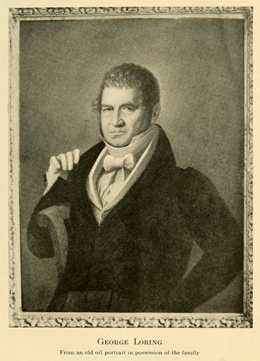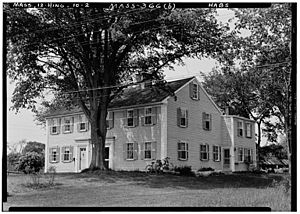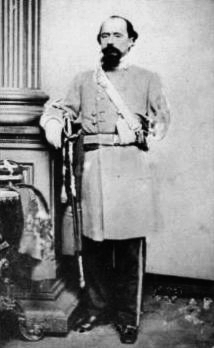Thomas Loring facts for kids
Thomas Loring was an early settler in Massachusetts. He helped start the towns of Hingham and Hull. Thomas Loring was a very important person in Hingham's early history. His family became well-known in Hull and stayed there for many years. People in 1893 already knew him as the ancestor of most Loring families in New England. His family members later fought on both sides of the American Revolution and the Civil War. Today, his descendants live all over the world, including North America, Spain, England, and Australia.
Contents
Early Life and Family
Thomas Loring was born in Axminster, a town in Devonshire, England. He married Jane Newton while still in England. Her grandson later said that Jane was a "lively" person. She was also "skilled in the practice of physick," which means she knew a lot about medicine.
Moving to Massachusetts Bay
Mr. Loring came to New England on December 23, 1634. He joined the church colony in Hingham. On March 3, 1635-36, he became a "freeman." This meant he was a full citizen of the colony. By then, he already had a home lot in Hingham. It was near where Town and Ship Streets are today. He later bought more land in the area.
His Jobs and Roles
Thomas Loring was a farmer. Fish were a very important food source for the settlers. They also used fish to make the soil rich for growing corn. In 1637, Thomas Loring and his neighbors got permission to build a weir. A weir is a fence or barrier built across a river or stream to catch fish. The stream where they built it is still called Weir River today.
He was also an innkeeper, which means he ran a place where travelers could eat and sleep. He might have been the first innkeeper in the Hingham area. The Massachusetts General Court, which was the colony's government, gave him a license in March 1637. The church also chose him to be one of its deacons. A deacon is a church leader who helps with its services and activities.
Important Role in Hingham's History
Thomas Loring played a big part in Hingham's early days. On March 12, 1637-38, he was allowed to sell "wine and strong water" as part of his innkeeper job. This showed that Hingham was becoming a more settled town.
We know the church in Hingham was formed by March 3, 1635-36. Thomas Loring was one of the eleven men known to live in Hingham who became "freemen" on that date. This means he was there from the very beginning of the church.
In 1828, a special inscription was placed on a large rock in Hingham. It celebrated the early settlers. Thomas Loring was one of the people named on this rock. The inscription honored these first settlers who came from Great Britain in 1635.
Moving to Hull, Massachusetts
On March 15, 1645-46, Thomas Loring's house burned down. He decided not to rebuild it in Hingham. Instead, he bought property in the nearby town of Hull. He quickly became an important person there. He served as a constable, which was a very important job back then. A constable was like a court officer and a tax collector. This job needed someone who was good at business and very efficient.
He also invested in a new settlement called "Sickonke," later known as Rehoboth. However, he did not move there or keep his land ownership.
Later, on April 10, 1656, a Native American man named Nauhawton sold a piece of land to Thomas Loring and the other people living in Hull. This land was known as "Nantascot," but it became the town of Hull.
His Property and Home
On May 30, 1660, Thomas Loring bought a large property in Hull. It included a house, an orchard, and two home lots. He also owned meadow land, two lots at Sagamore Hill, and two lots at Strawberry Hill. This property was very large and important. After he passed away, his sons carefully divided this property among themselves.
His son John married in 1657. Thomas bought land for John on Further Hill. On this land, a very old house is still standing today. It is a landmark "cape-style" home on Town (now Spring) Street.
Passing Away
Deacon Loring passed away on April 4, 1661. He did not leave a will. An inventory of his belongings was made on June 27, 1661. This document showed what his life was like and what he owned.
His Descendants
The Loring family was the only original family from Hull to have members fight in both the Revolutionary War and the Civil War. Thomas Loring's family members fought on both sides of the American Revolution. For example, Commodore Joshua Loring was a Loyalist, meaning he supported the British. His family also fought on both sides of the American Civil War. This included Confederate General William W. Loring.

Joshua Loring's descendants include Sir John Nigel Loring, who was an Apothecary (a type of pharmacist) to Queen Elizabeth The Queen Mother. Other descendants, Edward Greeley Loring and Charles Greeley Loring, were cousins who found themselves on opposite sides of a legal case about the Fugitive Slave Act.
Colonel Benjamin Loring, another descendant, led the Ancient and Honorable Artillery Company of Massachusetts in 1818. A building called Loring Hall was named after him. Built in 1835, it still serves as Hingham's movie theater today.
The family also includes writers, like Frederick Wadsworth Loring. A part of the family became successful merchants in Spain. They include Jorge Loring Martinez, who was a pioneer in aviation. The family also holds the title of the Marquis de Casa Loring, and the current Marquis is a descendant of Thomas Loring.
Categories



